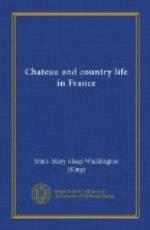I had one other curious experience, and after that I gave up trying anything that was a novelty or that they hadn’t seen all their lives. The French peasant is really conservative; and if left to himself, with no cheap political papers or socialist orators haranguing in the cafes on the eternal topic of the rich and the poor, he would be quite content to go on leading the life he and his fathers have always led—would never want to destroy or change anything.
I was staying one year with Lady Derby at Knowsley, in Christmas week, and I was present one afternoon when she was making her annual distribution of clothes to the village children. I was much pleased with some ulsters and some red cloaks she had for the girls. They were so pleased, too—broad smiles on their faces when they were called up and the cloaks put on their shoulders. They looked so warm and comfortable, when the little band trudged home across the snow. I had instantly visions of my school children attired in these cloaks, climbing our steep hills in the dark winter days.
I had a long consultation with Lady Margaret Cecil, Lady Derby’s daughter—a perfect saint, who spent all her life helping other people—and she gave me the catalogue of “Price Jones,” a well-known Welsh shop whose “specialite” was all sorts of clothes for country people, schools, workmen’s families, etc. I ordered a large collection of red cloaks, ulsters, and flannel shirts at a very reasonable price, and they promised to send them in the late summer, so that we should find them when we went back to France.
We found two large cases when we got home, and were quite pleased at all the nice warm cloaks we had in store for the winter.
As soon as the first real cold days began, about the end of November, the women used to appear at the chateau asking for warm clothes for the children. The first one to come was the wife of the “garde de Borny”—a slight, pale woman, the mother of nine small children (several of them were members of the school at St. Quentin, who had declined our soup, and I rather had their little pinched, bloodless faces in my mind when I first thought about it). She had three with her—a baby in her arms, a boy and a girl of six and seven, both bare-legged, the boy in an old worn-out jersey pulled over his chest, the girl in a ragged blue and white apron, a knitted shawl over her head and shoulders. The baby had a cloak. I don’t believe there was much on underneath, and the mother was literally a bundle of rags, her skirt so patched one could hardly make out the original colour, and a wonderful cloak all frayed at the ends and with holes in every direction. However, they were all clean.
The baby and the boy were soon provided for. The boy was much pleased with his flannel shirt. Then we produced the red cloak for the girl. The woman’s face fell: “Oh, no, Madame, I couldn’t take that; my little girl couldn’t wear it.” I, astounded: “But you don’t see what it is—a good, thick cloak that will cover her all up and keep her warm.” “Oh, no, Madame, she couldn’t wear that; all the people on the road would laugh at her! Cela ne se porte pas dans notre pays” (that is not worn in our country).




